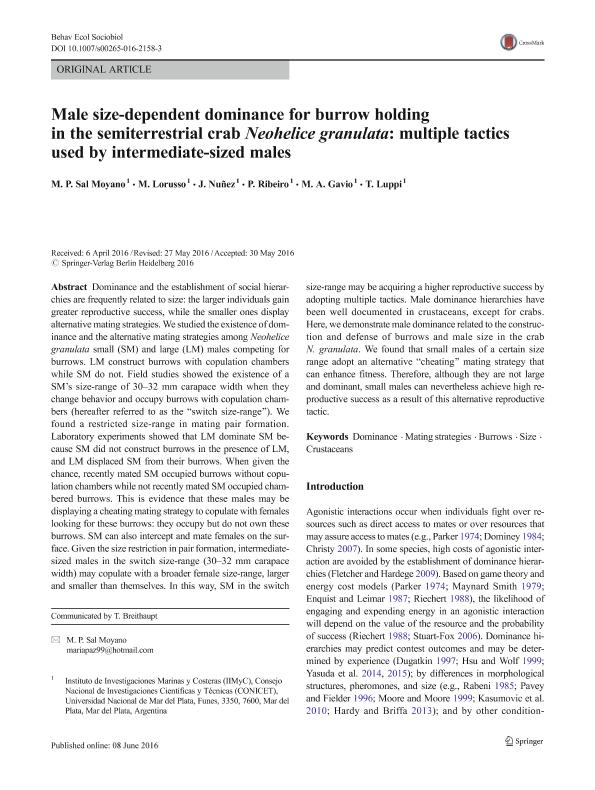Artículo
Male size-dependent dominance for burrow holding in the semiterrestrial crab Neohelice granulata: multiple tactics used by intermediate-sized males
Sal Moyano, María Paz ; Lorusso, M.; Nuñez, Jesus Dario
; Lorusso, M.; Nuñez, Jesus Dario ; Ribeiro, Pablo Damián
; Ribeiro, Pablo Damián ; Gavio, Maria Andrea; Luppi, Tomas Atilio
; Gavio, Maria Andrea; Luppi, Tomas Atilio
 ; Lorusso, M.; Nuñez, Jesus Dario
; Lorusso, M.; Nuñez, Jesus Dario ; Ribeiro, Pablo Damián
; Ribeiro, Pablo Damián ; Gavio, Maria Andrea; Luppi, Tomas Atilio
; Gavio, Maria Andrea; Luppi, Tomas Atilio
Fecha de publicación:
08/09/2016
Editorial:
Springer
Revista:
Behavioral Ecology And Sociobiology
ISSN:
0340-5443
Idioma:
Inglés
Tipo de recurso:
Artículo publicado
Clasificación temática:
Resumen
Dominance and the establishment of social hierarchies are frequently related to size: the larger individuals gain greater reproductive success, while the smaller ones display alternative mating strategies. We studied the existence of dominance and the alternative mating strategies among Neohelice granulata small (SM) and large (LM) males competing for burrows. LM construct burrows with copulation chambers while SM do not. Field studies showed the existence of a SM’s size-range of 30–32 mm carapace width when they change behavior and occupy burrows with copulation chambers (hereafter referred to as the “switch size-range”). We found a restricted size-range in mating pair formation. Laboratory experiments showed that LM dominate SM because SM did not construct burrows in the presence of LM, and LM displaced SM from their burrows. When given the chance, recently mated SM occupied burrows without copulation chambers while not recently mated SM occupied chambered burrows. This is evidence that these males may be displaying a cheating mating strategy to copulate with females looking for these burrows: they occupy but do not own these burrows. SM can also intercept and mate females on the surface. Given the size restriction in pair formation, intermediate-sized males in the switch size-range (30–32 mm carapace width) may copulate with a broader female size-range, larger and smaller than themselves. In this way, SM in the switch size-range may be acquiring a higher reproductive success by adopting multiple tactics. Male dominance hierarchies have been well documented in crustaceans, except for crabs. Here, we demonstrate male dominance related to the construction and defense of burrows and male size in the crab N. granulata. We found that small males of a certain size range adopt an alternative “cheating” mating strategy that can enhance fitness. Therefore, although they are not large and dominant, small males can nevertheless achieve high reproductive success as a result of this alternative reproductive tactic.
Palabras clave:
Burrows
,
Crustaceans
,
Dominance
,
Mating Strategies
,
Size
Archivos asociados
Licencia
Identificadores
Colecciones
Articulos(IIMYC)
Articulos de INSTITUTO DE INVESTIGACIONES MARINAS Y COSTERAS
Articulos de INSTITUTO DE INVESTIGACIONES MARINAS Y COSTERAS
Citación
Sal Moyano, María Paz; Lorusso, M.; Nuñez, Jesus Dario; Ribeiro, Pablo Damián; Gavio, Maria Andrea; et al.; Male size-dependent dominance for burrow holding in the semiterrestrial crab Neohelice granulata: multiple tactics used by intermediate-sized males; Springer; Behavioral Ecology And Sociobiology; 70; 9; 8-9-2016; 1497-1505
Compartir
Altmétricas



